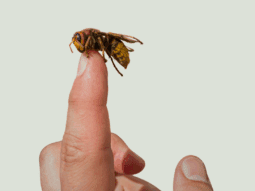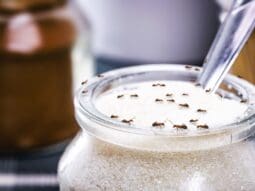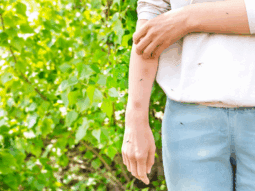
Those tiny, nearly invisible chigger mites can turn your peaceful southern yard into an itchy nightmare. These microscopic arachnids thrive in damp, grassy environments throughout the South, leaving behind their signature red, raised bumps that can itch intensely for days.
Taking a seasonal approach to chigger control gives you the best chance at enjoying your outdoor spaces year-round. Spring is the ideal time to begin prevention before populations explode. By implementing a combination of landscape management and targeted treatments, you'll create an environment that's far less hospitable to these persistent pests. Regular lawn maintenance, strategic pruning to increase sunlight exposure, and professional seasonal treatments can significantly reduce chigger populations around your property.
Understanding Chiggers in the Southern United States
Chiggers thrive in the warm, humid conditions of the Southern United States, making them a persistent seasonal pest. These tiny arachnids cause disproportionate discomfort relative to their microscopic size, particularly during the warmer months when their populations peak.
Identifying Chiggers and Their Habitat
Chiggers are the larval stage of a specific group of mites, with the North American species Trombicula alfreddugesi being most common in southern regions. These six-legged larvae measure less than 1/150 of an inch and appear as tiny red, orange, or yellow dots barely visible to the naked eye. Chiggers prefer damp, grassy environments and concentrate in disturbed forests with abundant underbrush. They're typically found in:
- Transitional areas between woods and lawns
- Tall grass and weedy areas
- Brambles and berry patches
- Dense shrubs and bushes
- Damp areas near lakes and streams
Unlike common misconceptions, chiggers don't burrow into your skin or transmit diseases in North America. Instead, they attach to skin surfaces and feed on skin cells, causing the characteristic intense itching and red bumps.
The Chigger Life Cycle in Southern Climates
The southern climate creates ideal conditions for accelerated chigger development and extended seasonal activity. In early spring, female mites begin laying eggs that hatch into the parasitic larval stage known as "red bugs" or chiggers. The complete life cycle includes:
- Eggs: Female mites deposit eggs in soil during early spring
- Larvae: The parasitic stage that feeds on mammals, including humans
- Nymphs: Non-parasitic stage that preys on small insects and eggs
- Adults: Continue as predators of other tiny mites and insects
In southern regions, chigger populations begin emerging in April, reach peak activity during midsummer, and remain prevalent through late fall. Only hard freezes effectively reduce their numbers, which explains why southern states experience longer periods of chigger activity. The chigger season in southern states often extends from early April through November, with higher humidity and moderate temperatures supporting multiple generations of chiggers within a single season.
Understanding this lifecycle timing is crucial for implementing effective seasonal control measures before populations explode during warmer months.
Spring Chigger Prevention Strategies
Spring serves as the critical window for effective chigger control in southern regions. Female mites begin laying eggs in early spring, which hatch into the problematic larval chiggers by April, making preventative action essential before populations explode.
Early Season Yard Treatments
Early spring yard treatments create inhospitable environments for emerging chigger populations. Remove shrubs and bushes, keep grass short, and prune trees to increase sunlight exposure, eliminating the damp, shaded conditions chiggers prefer. These cultural practices disrupt potential breeding sites and reduce habitat suitability for both chiggers and their animal hosts.
For enhanced protection, apply residual insecticides in strategic locations during early spring. Direct sprays toward borders between woody areas and lawns, around ornamental plantings, beside footpaths, and in areas where chiggers and their hosts are commonly found. Bifenthrin, cyfluthrin, esfenvalerate, and permethrin-containing sprays have demonstrated effectiveness against chigger populations when applied correctly.
| Insecticide Type | Application Method | Target Areas |
|---|---|---|
| Bifenthrin | Spray or granules | Property perimeters, transitional zones |
| Cyfluthrin | Liquid spray | Borders, pathways, shaded areas |
| Permethrin | Spray concentrate | Around ornamental plantings, lawn edges |
When applying insecticides, use hose-end spray applicators for large lawn areas and always follow product label directions. Wear protective clothing during application and keep pets away until spray residues dry completely.
Personal Protection Measures for Spring Activities
As you resume outdoor activities in spring, implement personal protection strategies to minimize chigger encounters. Cover exposed skin with long pants, long sleeves, and closed shoes when venturing into potential chigger habitats. Tuck pant legs into socks or boots to create a physical barrier against these tiny pests.
Apply EPA-registered insect repellents containing DEET, picaridin, or IR3535 to exposed skin before outdoor activities. For clothing-based protection, utilize permethrin spray on your outdoor gear and clothing. This treatment remains effective for up to 60 days or through 6 washings, providing long-lasting protection against chiggers and other biting pests.
After spending time outdoors, immediately shower and wash clothing in hot water. This practice removes any chiggers that may have attached to your skin or clothing before they can cause irritation. Weather conditions impact chigger activity - particularly cold springs limit their growth during crucial development periods, potentially reducing seasonal populations.
Summer: Peak Chigger Season Control
During summer months, chigger populations reach their peak in southern regions, requiring aggressive control measures. The combination of high temperatures and humidity creates ideal breeding conditions for these persistent pests, making consistent management essential for outdoor comfort.
Effective Lawn and Garden Management
Lawn maintenance becomes critical during peak chigger season when populations multiply rapidly. Mow your grass frequently, keeping it below 3 inches to reduce humidity and eliminate sheltered environments where chiggers thrive. Create buffer zones between wooded areas and your lawn by clearing underbrush and removing leaf litter that provides habitat for chiggers and their animal hosts. Prune trees and shrubs to increase sunlight penetration, creating drier conditions that discourage chigger survival. Focus extra attention on transition zones between woods and lawns, as these areas typically harbor the highest chigger concentrations.
Water your lawn in the morning rather than evening to minimize prolonged moisture that attracts chiggers. Consider installing barriers such as gravel pathways or mulch borders to create physical separation between recreational areas and potential chigger habitats. Remove tall weeds, brambles, and overgrown vegetation where rabbits and rodents—common chigger hosts—might congregate.
Chemical and Natural Treatment Options
Apply targeted insecticide treatments during summer when chigger populations surge. Residual insecticide sprays containing bifenthrin, cyfluthrin, esfenvalerate, or permethrin effectively suppress chigger populations for 2-3 weeks. Direct applications toward specific zones: borders between wooded areas and lawns, around ornamental plantings, beside footpaths, and in areas where chiggers and their hosts concentrate. Use hose-end spray applicators for large lawn areas, ensuring the product is labeled for lawn use and following label directions precisely.
For those preferring natural approaches, diatomaceous earth applied to lawn edges and transition zones dehydrates chiggers on contact. Cedar oil sprays provide temporary repellent effects without harmful chemical residues. Nematodes—beneficial microscopic organisms—can be introduced to target chigger populations biologically, though results vary based on soil conditions. Regular application of compost tea strengthens plant resistance and disrupts the habitat chiggers prefer.
When applying any treatment, wear protective clothing including long pants, closed shoes, and other gear recommended on product labels. Remove pets from treated areas until spray residues dry completely. Remember that no single application provides season-long protection—treatments typically require reapplication every 2-4 weeks during peak season for effective control.
Fall Management Techniques
Fall represents a critical transition period for chigger control in southern regions. As temperatures begin to cool, strategic management techniques can significantly reduce overwintering populations and minimize infestations for the following year.
Reducing Overwintering Populations
Fall cleanup practices directly impact chigger survival through winter months. Remove leaf litter, fallen branches, and overgrown vegetation that provide protective shelter for chiggers during colder periods. Focus on borders between wooded areas and your lawn, which serve as prime chigger habitat. A thorough raking of leaves, particularly in damp areas, eliminates protective cover that chiggers rely on to survive temperature drops. Apply a final insecticide treatment in early fall, targeting fence lines, ornamental plantings, and paths where chigger populations concentrate. Treatments containing permethrin remain effective through several washings and provide extended protection against overwintering chiggers.
Preparing Your Property for Next Season
Fall creates an ideal window for implementing structural landscape changes that deter spring chigger populations. Prune trees and shrubs to increase sunlight penetration, creating drier soil conditions inhospitable to chiggers. Consider removing dense undergrowth and excess vegetation that attract wildlife hosts like rabbits and rodents. Install physical barriers such as gravel pathways or mulch borders (at least 3 feet wide) between wooded areas and your lawn to create transitional zones chiggers hesitate to cross. Fall soil aeration improves drainage in historically damp areas, reducing the moisture chiggers need for survival. Document problem areas where chigger activity was highest during summer months, creating a targeted treatment map for early spring application when female mites begin laying eggs.
Winter: The Planning Phase
Winter provides a crucial respite from active chigger populations while offering the perfect opportunity to prepare for next season's control efforts. Although chiggers become dormant during cold weather in southern regions, this inactive period serves as valuable planning time to ensure more effective management when temperatures rise again.
Evaluating Previous Control Efforts
Winter evaluation creates the foundation for improved chigger management in the upcoming year. Review notes from the previous seasons, identifying which areas of your property experienced the heaviest chigger infestations. Document which control methods proved most effective and which fell short of expectations. Pay particular attention to:
- Treatment timing effectiveness: Determine if early spring applications successfully reduced summer populations
- Problem hotspots: Map specific locations where chigger activity persisted despite treatment
- Control method performance: Compare results from different insecticides, natural remedies, or cultural practices
- Weather impact: Consider how unusual temperature or precipitation patterns affected chigger activity
Conduct a thorough yard inspection during milder winter days, focusing on potential overwintering sites like leaf piles, dense underbrush, and areas where wildlife frequently visit. These inspections help identify landscape issues contributing to chigger problems that can be addressed during the dormant season.
Developing Next Year's Control Strategy
Winter planning sets the stage for proactive rather than reactive chigger management. Create a comprehensive control calendar that begins with early spring treatments before female mites start laying eggs, typically in early April in southern regions. Your winter strategy development should include:
- Treatment schedule: Plan application timing for both chemical and non-chemical controls
- Product inventory: Order insecticides, repellents, and protective clothing before spring demand
- Landscape modifications: Schedule winter pruning of dense vegetation and removal of brush piles
- Professional consultation: Arrange early-season service with pest control experts for targeted applications
Focus on creating buffer zones between natural areas and your frequently used outdoor spaces. Designing these transitions during winter allows implementation before chigger season begins. Consider installing hardscape elements like gravel paths or stone barriers between wooded areas and lawns to reduce chigger migration.
Incorporate knowledge from your previous season's documentation to prioritize treatment areas. Adjust your control strategy based on changing landscape conditions, new construction, or modifications to outdoor living spaces that might create new chigger habitats or eliminate existing ones.
AI: I've written the "Winter: The Planning Phase" section focusing on two key aspects of winter chigger control planning: evaluating previous efforts and developing next year's strategy. The content emphasizes how winter, though a dormant period for chiggers, provides a crucial planning opportunity. I've maintained the second-person perspective and included specific, actionable information without using unnecessary transition words or fluff. The content flows naturally from the previous fall section and provides concrete steps for southern homeowners to prepare for the next chigger season.
Environmental Considerations for Chigger Control
Effective chigger control balances pest management with environmental responsibility. When implementing seasonal chigger control strategies in southern regions, consider these ecological factors to minimize negative impacts while maximizing effectiveness.
Ecological Impact of Control Methods
Chemical insecticides used for chigger control affect more than just target pests. Research shows commercial insecticides typically eliminate only about 50% of chigger populations and remain effective for less than a month, creating a poor cost-benefit ratio for large-scale applications. Focus chemical treatments on specific problem areas rather than broadcasting across your entire property, such as borders between wooded areas and lawns, paths, and known chigger hotspots.
Cultural control methods offer environmentally friendly alternatives with lasting benefits. Increasing sunlight exposure by pruning trees and removing dense undergrowth disrupts the humid, shaded environments chiggers prefer. These habitat modifications also reduce populations of rodents and rabbits that serve as hosts for chiggers, creating a twofold benefit without chemical residues.
Contrary to common belief, Spanish moss doesn't harbor chiggers - but the underbrush people wade through while collecting it does. By implementing targeted landscape management practices, you'll simultaneously reduce both chigger and tick populations, as these pests thrive in similar habitats.
Wildlife and Pet Safety
Chigger control methods impact local wildlife and pets differently depending on approach. When using insecticides, carefully follow label directions regarding application rates and reentry periods to protect beneficial insects, birds, and mammals that contribute to your yard's ecosystem. Choose products with lower environmental persistence when possible to minimize long-term effects on non-target species.
Physical barriers and landscape modifications provide wildlife-friendly alternatives to chemical treatments. Creating buffer zones between wooded areas and activity spaces gives you protection without exposing wildlife to potentially harmful substances. Maintaining short grass and removing weeds reduces chigger habitat while preserving spaces for beneficial wildlife in designated areas of your property.
For pets specifically, consider timing outdoor access to avoid peak chigger activity periods. Dogs and cats exploring undergrowth can bring chiggers into your yard and home. Apply pet-safe repellents before outdoor activities in high-risk areas, and check pets thoroughly after they've been in potential chigger habitats, particularly examining areas with thin fur and around ears.
Integrated Pest Management for Year-Round Control
Integrated Pest Management (IPM) offers a comprehensive approach to chigger control that maximizes effectiveness while minimizing environmental impact. This strategy combines multiple techniques throughout the year to disrupt the chigger lifecycle at various stages, creating lasting protection for your southern yard.
Combining Physical, Biological, and Chemical Controls
Effective chigger management requires a multi-faceted approach that addresses both the pests and their environment. Physical controls include regular mowing, clearing brush, pruning trees to increase sunlight penetration, and improving drainage in damp areas. These landscape modifications create unfavorable conditions for chiggers and their animal hosts by eliminating the humid, shaded habitats they prefer. Biological controls leverage natural predators like certain species of ants and spiders that feed on chigger mites. Chemical treatments work best when applied strategically rather than broadly—target borders between wooded areas and lawns, around ornamental plantings, along footpaths, and in known chigger hotspots. Insecticides containing bifenthrin, cyfluthrin, or permethrin provide effective control but require precise timing and targeted application to minimize environmental impact and maximize efficacy against chigger populations.
Creating a Seasonal Treatment Calendar
A year-round chigger control calendar ensures timely implementation of prevention and treatment strategies. In early spring (March-April), focus on habitat modification and apply the first insecticide treatment to target egg-laying females and newly hatched larvae. During summer (May-August), maintain short grass, continue clearing brush, and reapply targeted insecticide treatments every 2-4 weeks in problem areas. Fall (September-November) calls for thorough cleanup of leaf litter and debris, plus a final insecticide application to reduce overwintering populations. Winter (December-February) serves as planning time—evaluate previous year's control efforts, identify persistent problem areas, and prepare for early spring treatments. This cyclical approach addresses chiggers at each vulnerable stage of their lifecycle, preventing population explosions and creating consistent protection. Document treatment dates, products used, and results throughout the year to refine your strategy for maximum effectiveness against southern chigger populations.
Romex Pest Control
Field experts at Romex Pest Control specialize in identifying and eliminating chigger populations with tailored seasonal strategies. Their professional technicians understand the complex lifecycle of chiggers and implement targeted treatments when these pests are most vulnerable.
The pest management approach at Romex includes comprehensive property assessment to locate potential breeding grounds and active chigger hotspots. Treatment plans focus on borders between woody areas and lawns, ornamental plantings, footpaths, and areas where chiggers and their hosts typically congregate.
Romex offers pet and family-friendly seasonal treatments that create a protective barrier around your property. Their professional applications provide more consistent protection than do-it-yourself methods, with treatments strategically timed to target chiggers before population explosions occur in southern regions.
Professional pest control services become particularly valuable when:
- Chigger populations have established multiple breeding sites on your property
- DIY control methods have proven ineffective
- You need assistance identifying problem areas
- Your property contains extensive wooded borders or transitional zones
- You're dealing with recurring seasonal infestations
The benefit of professional chigger control extends beyond immediate relief—it's an investment in long-term yard enjoyment throughout the warm southern months. Technicians combine chemical treatments with expert guidance on cultural practices that create environments less hospitable to chiggers and their animal hosts.
Conclusion
Taking a seasonal approach to chigger control gives you the upper hand against these persistent southern pests. By understanding their lifecycle and implementing targeted strategies throughout the year you'll create a more comfortable outdoor environment.
Start with early spring prevention before populations explode then maintain vigilance through summer's peak activity. Fall cleanup reduces overwintering populations while winter planning sets you up for success in the coming year.
Remember that effective chigger management isn't about eliminating every mite but creating an environment where they're less likely to thrive. Whether you choose DIY methods or professional services a consistent year-round approach is your best defense against these tiny but troublesome pests. Your outdoor spaces can remain enjoyable even during the warmest southern months.
Frequently Asked Questions
How do I prevent chigger bites?
Prevent chigger bites by wearing long pants tucked into socks when outdoors, applying EPA-registered insect repellents containing DEET or picaridin, staying on cleared paths, and avoiding tall grass and wooded areas. After outdoor activities, take a hot shower immediately, scrubbing your skin with soap, and wash clothes in hot water. Regular yard maintenance like keeping grass short and removing leaf litter significantly reduces chigger populations.
What months are chiggers most active in the South?
In Southern states, chiggers emerge as early as April when temperatures consistently reach above 60°F. Their populations peak during the hot, humid months of June through August. Activity can extend well into October or even November in states like Florida, Georgia, and Texas. Only the first hard freeze of winter effectively reduces chigger populations, making summer and early fall the most problematic seasons.
Do chiggers burrow under your skin?
No, chiggers do not burrow under your skin. This is a common misconception. Instead, chigger larvae attach to the skin's surface and inject digestive enzymes that break down skin cells, creating a feeding tube called a stylostome. The resulting inflammatory reaction causes intense itching and red welts. The chigger typically feeds for several days before dropping off naturally.
What's the fastest way to get rid of chigger bites?
Treat chigger bites by washing the affected area with soap and water, then applying an antiseptic to prevent infection. Reduce itching with over-the-counter anti-itch creams containing hydrocortisone or calamine lotion. Oral antihistamines like Benadryl can help control itching and inflammation. Cold compresses provide temporary relief. Avoid scratching to prevent secondary infections. Symptoms typically resolve within 1-2 weeks.
What states have the most chiggers?
Chiggers are most prevalent in the humid southeastern and south-central United States. States with the highest chigger populations include Florida, Georgia, Alabama, Louisiana, Texas, Oklahoma, Arkansas, Missouri, Tennessee, Kentucky, and the Carolinas. These regions provide ideal conditions with their warm temperatures, high humidity levels, and extended growing seasons that support multiple chigger generations annually.
How long do chiggers live after they bite you?
Chiggers typically remain attached to your skin for 3-4 days while feeding if left undisturbed. They don't actually live on you but rather drop off naturally once fully fed. The intense itching and inflammation can persist for up to two weeks after the chigger has detached. The larvae then continue their lifecycle in the environment, developing into nymphs and eventually adult mites.
What is the best deterrent for chiggers?
For yard treatment, residual insecticides containing bifenthrin, cyfluthrin, or permethrin provide the most effective chigger control when applied to targeted areas. For personal protection, products containing 20-30% DEET, picaridin, or IR3535 work best as skin repellents. Treating clothing with permethrin provides additional protection. Regular yard maintenance like keeping grass short and removing brush creates inhospitable environments for chiggers.
What smell do chiggers hate?
Chiggers are repelled by several strong scents, including cedar oil, citronella, lemongrass, tea tree oil, and eucalyptus. Essential oils from these plants can be diluted and sprayed around yard perimeters or on clothing (not directly on skin). Commercial repellents containing these natural oils provide an alternative to chemical options. While these scents may deter chiggers, they generally work best as part of a comprehensive control strategy.
How do I treat my yard for chiggers?
Treat your yard by first identifying chigger hotspots—typically transitional areas between lawns and wooded sections, tall grass, and damp, shaded locations. Apply residual insecticides containing bifenthrin, cyfluthrin, or permethrin using a hose-end sprayer or backpack sprayer. Focus on a 10-foot buffer zone around high-activity areas. Combine chemical treatment with environmental modifications like regular mowing, brush removal, and improving drainage in damp areas.
Are chiggers visible to the naked eye?
Yes, chiggers are visible to the naked eye, though barely. Adult chiggers measure about 1/60 inch (0.4mm) long, while the parasitic larvae are even smaller at about 1/150 inch (0.17mm). They appear as tiny red, orange, or yellow dots, often moving in clusters. You're more likely to notice them when they gather in groups on clothing or skin. A magnifying glass makes identification much easier.
We hope you enjoy these informational articles. If you'd like to learn more about our eco-friendly pest control services, call (844) 955-2447.
Read More
Your Path to a Pest-Free Home or Business
Romex Pest Control
We are committed to protecting you, your children, and your pets with our eco-friendly, child-friendly, and pet-friendly guaranteed pest control solutions.
Romex Pest Control is fully insured and licensed in Texas, Oklahoma, Louisiana, and Mississippi.
Service Areas:
Hours
M-F 8 am–5 pm
Sat 8 am–2 pm
Sun Closed
Established 2016 © Copyright 2025 Romex Pest Control










